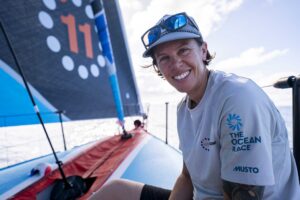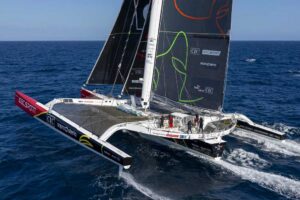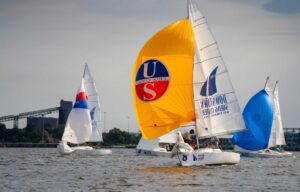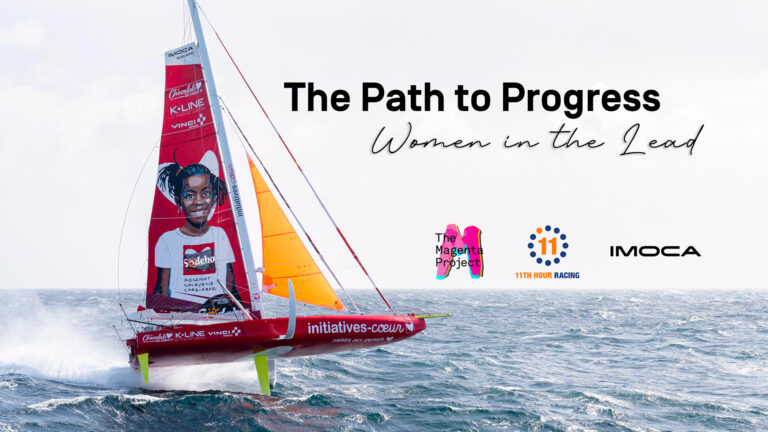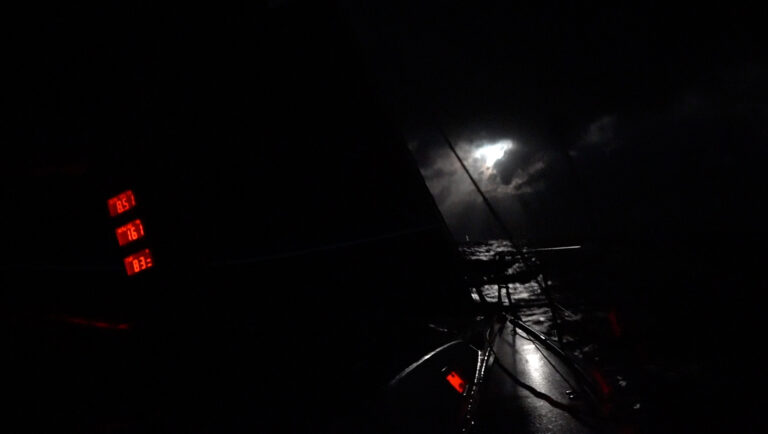Morning starts early for 29-year-old Charlie Enright, a native of Bristol, Rhode Island, who is skippering Team Alvimedica in the 2014-15 Volvo Ocean Race. The lights flick on at 0600, an iPhone is tapped and a torrent of email begins before the young skipper is vertical.
By 0900, Enright and his teammates are in the gym for an intense two-hour workout. Then it’s back to the business-as-usual routine of running a multi-million-dollar VOR campaign that involves sponsors, sailors and suppliers, and stretches from Auckland, New Zealand, to Istanbul, Turkey. “You need to lead by example,” says Enright of the physical fitness and mental toughness that are required to compete at this level. “Everybody has their strengths and weaknesses, but nobody should ever question effort.”
Anyone who knows Enright knows better than to question his effort when it comes to the VOR. After all, global corporations don’t just haphazardly hand over the keys to a brand-new Volvo Ocean 65 one-design raceboat, not to mention the funding needed to lead a group of young sailors around the world, without having a high degree of confidence in the skipper’s sailing experience and leadership skills. How, though, does one garner such skills and experience before reaching the tender age of 30? In this case, the answer is simple: Mickey Mouse.
The Dawn of a Career
In 2006 the Walt Disney Company issued a request for applications from young sailors to race aboard Morning Light, a tricked-out TP52, in the 2007 Transpac Race, with an eye toward turning this youthful adventure into a feature-length film. One of these applicants was Enright, then an undergraduate at Brown University, where he was earning a business degree. Another was Mark Towill of Honolulu, Hawaii, then a high school senior.
Both Enright and Towill, who is now 25, impressed their all-star coaches—including 2010 Rolex Yachtsman of the Year Stan Honey and VOR champion Mike Sanderson—with their work ethic and their commitment to racing a high-performance monohull across an ocean with a crew of nine other youngsters, sans “adult” supervision. And while Disney’s feature-length film about their adventure—also dubbed “Morning Light”—may have struggled in theaters, for Enright and Towill the experience proved instrumental for all that has come since.
“‘Morning Light’ was a massive experience, not only offshore, but the coaches also gave me a porthole into the world of the VOR,” says Enright, who served as a watch captain and first began dreaming about the VOR while on that Transpac. “It was a natural conversation, because [Sanderson] and Honey had just won the 2005-06 race.”
The campaign was also important in terms of the connections it allowed the two of them to make, including, of course, with one another. While the laid-back Hawaiian was the youngest sailor aboard the TP52, he quickly proved his skills and work ethic, and he and Enright forged a tight bond based on shared dreams of racing faster boats across even wider oceans.
The next year Towill joined Enright on Brown University’s sailing team, and their VOR dream continued to mature. Enright graduated in 2008 and took a sales gig with North Sails, while Towill earned a double degree in economics and environmental studies, which he completed in 2011.
That same year the pair also had the opportunity to do some more offshore sailing together as part of the All American Offshore Team (AAOT), under the aegis of the Oakcliff Sailing Center in Oyster Bay, New York—a program that was made possible by a loan of the STP65 Vanquish (formerly Moneypenny) and served as a kind of informal graduate program and senior thesis in organizing an offshore racing campaign. For both sailors it was another major step on their way toward their goal of racing around the world.
“We were given a boat, but it was on us to raise the money and to put our training together,” says Towill, who serves on Team Alvimedica as a watch captain and general manager. “We wanted to give up-and-comers the experience of ocean racing.”
Enright, who served as the AAOT’s skipper, adds that as part of this effort they realized that the best way to raise funds was to generate strong media content, à la the Volvo Ocean Race. This, in turn, led him to contact renowned photographer and videographer Amory Ross, to see what they could put together.
“I had a tool they could utilize and they had a boat,” says Ross, who joined Vanquish in Annapolis for the team’s first distance race to Newport, the 2011 Transatlantic Race and a storm-tossed Fastnet. He later served as the media crewmember (now called the “onboard reporter,” or OBR) aboard Puma Ocean Racing’s Mar Mostro in the 2011-12 VOR.
“I hadn’t been hired on Puma yet, the VOR wasn’t far away and I needed to practice and build my portfolio,” says Ross. “I got all of my rookie mistakes out of the way with the AAOT,” he adds, recalling one ill-fated idea he had about attaching a GoPro camera to a kite, which he launched from the pushpit only to get his finger sliced open by the kite’s string when it crashed.
Equally important, Ross’s work with AAOT eventually caught the attention of Knut Frostad, CEO of the VOR, which resulted in Enright and Towill being invited to the start of the 2011-12 VOR in Alicante, Spain, where they met with Frostad, who carefully coached the eager Americans.
“The acid test for me with [Enright and Towill] was clearly that from day one, they were willing to put in the hours and mileage to make it happen,” says Frostad. “I encouraged them to spend the next two years learning how to put a team together and raise the funding. After all, getting to the starting line is the hardest part of the journey.”
All this was fine with Enright and Towill, who were now both fully committed to their dream: never mind the additional challenge of being Americans far removed from Europe’s culture of sponsored sailing. “It was always the plan to create our own opportunities,” says Enright of the decision to build their own VOR team, rather than joining an existing squad. “Racing as a team was always our goal.”
A Whole New Race
The biggest change to this year’s VOR format is that it has transitioned from a box-rule contest to a one-design competition [See sidebar, “The Boat”]. For a startup team like Team Alvimedica, the fact that the Farr-designed boats are all built to identical specifications removes the daunting hurdle of creating a boat from scratch.
“I wouldn’t want to sail around the world on a boat that I built myself,” jokes Enright, whose grandfather, Clint Pearson, co-founded Pearson Yachts and later formed Bristol Yachts. “Green Marine is building these boats tight and right, and [all teams] are in the same boat in this respect.”
And while fans of “bleeding-edge” sailing technology might be disappointed with the notion of identical boats sprinting around the planet, a one-design fleet race promises razor-thin finish-line deltas, as well as a clearly defined supply chain, shared in-port repair services, and generally simplified logistics. “I think it will be the closest VOR that we’ve ever seen,” says Towill. “The race will be a game of inches, with an emphasis on good trimming and fast driving.”
Of course, from a skipper’s standpoint, this added emphasis on boathandling places that much more of a load, both physically and mentally, on the individual sailors. True, the boats are five feet shorter and slightly de-tuned compared to the old box-rule VOR 70s. However, previous VORs allowed teams to sail with 11 crew, while the new rules limit each all-male team to eight, plus a dedicated OBR. Most teams, therefore, are hiring grizzled veterans. Not so on Team Alvimedica. “Alvimedica is a young company, and fielding the youngest team in the race is one of their priorities,” says Towill. “Our objectives are to help Alvimedica hit their [market-growth] goals and hopefully steal a few podium finishes.”
To this end, they have taken on a whole cadre of younger sailors, including fellow Americans Matt Noble and Nick Dana, Italian sailor Alberto Bolzan, and New Zealand sailors Ryan Houston and Dave Swete, who are all in their early 30s or younger.
The one “grizzled veteran” in the bunch is the team’s Australian navigator, Will Oxley, who served on the 2008-09 Puma team—a fitting partner for Enright, who has roughly 15,000 miles in his wake and is the only skipper in this year’s race who hasn’t completed a circumnavigation. “Sailing around the world and sailing in the Southern Ocean are binary experiences—you’ve either done it or you haven’t,” says Enright. “I haven’t done it yet, but I’m ready.”
To help mold the Alvimedica crew into a true team, Enright, Towill and Alvimedica’s shoreside CEO, BMW Oracle Racing veteran Bill Erkelens, have been running an aggressive boat-testing program over the past few months. Among their training exercises have been a transatlantic passage from Portugal to Newport, Rhode Island, in late May, followed by a return transatlantic in early July so the team could compete in the Sevenstar Round Britain and Ireland Race before heading off to Alicante for the start of the VOR on October 4. “We need to sail long passages offshore,” says Enright. “We need to live, breathe, eat and sleep on the boat.”
As far as pecuniary concerns go, Enright is smart enough not to reveal his team’s actual operating budget, but admits he’s still chasing down dollars. “We have a budget that permits us to do the race, but I’m seeking funding for the other auxiliary resources that the other teams have at their disposal,” he says, referring to hotel rooms, flights, rental cars and a myriad of other details.
But while the proposition of a low-budget race around the world—competing against teams with appreciably deeper pockets and greater experience—would be psychologically crippling for some sailors, Enright and Towill are comfortable with their underdog status. After all, the two faced any number of far more experienced teams when they raced Vanquish in 2011, but that didn’t stop them from finishing fifth in class and third overall in the 2011 Transatlantic Race, not to mention the fact they won the youth division in both the transatlantic and the Fastnet races. “We’re hungry, and we’re not going to leave anything on the table,” Enright says of his mindset in the run-up to the VOR.
Of course, it’s hard to write about an American-led VOR campaign without referencing Puma Ocean Racing’s 2008-09 and 2011-12 campaigns, especially given the way skipper Ken Read was equally enamored of the “underdog” label. And while Read’s underdog status was always debatable, Enright’s connection to Read—his boss at North Sails and a fellow Newport resident—is not. “I’ve talked to Read about what it’s like to be skipper, and he’s been unbelievably supportive,” says Enright of their relationship.
Ross, who has had the unique opportunity to observe both skippers at length in their natural environments, so to speak, adds that they are similar in their management styles as well. “Some skippers are hands-on—they want to drive all the time and micro-manage,” says Ross. “Kenny was more of a macro-level thinker, implicitly trusting our team of veterans to sail to their strengths. Charlie’s a great driver, but he, too, trusts the sailors around him with responsibility, while enjoying the bigger picture.”
How this will play out in the months to come is an open question. But talk to Enright and Towill, and their infectious enthusiasm quickly convinces you that they are not in this to participate, but to succeed. “It’s incredible how humble they are,” Ross says of the team’s two leaders. “As long as they stay honest and fun, I think that we’re going to see something in this VOR that we haven’t seen in a long time.”
David Schmidt is a longtime sailor and journalist, with experience on offshore steeds ranging from Corinthean-level keelboats to Grand Prix-level super maxis. He serves as the U.S. Editor of Sail-World.com, as well as an editor-at-large for SAIL Magazine. He lives and sails with his wife in Seattle, WA


